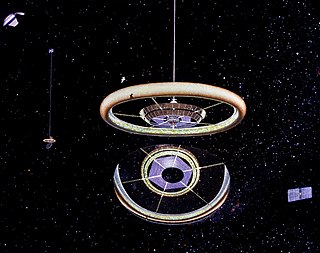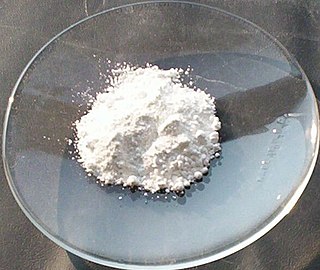
A fullerene is an allotrope of carbon whose molecule consists of carbon atoms connected by single and double bonds so as to form a closed or partially closed mesh, with fused rings of five to seven atoms. The molecule may be a hollow sphere, ellipsoid, tube, or many other shapes and sizes. Graphene, which is a flat mesh of regular hexagonal rings, can be seen as an extreme member of the family.

Nanomedicine is the medical application of nanotechnology. Nanomedicine ranges from the medical applications of nanomaterials and biological devices, to nanoelectronic biosensors, and even possible future applications of molecular nanotechnology such as biological machines. Current problems for nanomedicine involve understanding the issues related to toxicity and environmental impact of nanoscale materials.

The Stanford torus is a proposed NASA design for a space habitat capable of housing 10,000 to 140,000 permanent residents.

Zinc oxide is an inorganic compound with the formula ZnO. ZnO is a white powder that is insoluble in water, and it is widely used as an additive in numerous materials and products including rubbers, plastics, ceramics, glass, cement, lubricants, paints, ointments, adhesives, sealants, pigments, foods, batteries, ferrites, fire retardants, and first-aid tapes. Although it occurs naturally as the mineral zincite, most zinc oxide is produced synthetically.
In physics, the Faraday effect or Faraday rotation is a magneto-optical phenomenon—that is, an interaction between light and a magnetic field in a medium. The Faraday effect causes a rotation of the plane of polarization which is linearly proportional to the component of the magnetic field in the direction of propagation. Formally, it is a special case of gyroelectromagnetism obtained when the dielectric permittivity tensor is diagonal.

δ-Aminolevulinic acid, an endogenous non-proteinogenic amino acid, is the first compound in the porphyrin synthesis pathway, the pathway that leads to heme in mammals and chlorophyll in plants.

Nanomaterials describe, in principle, materials of which a single unit is sized between 1 to 1000 nanometres but usually is 1 to 100 nm.

Nanoparticles are particles between 1 and 100 nanometres (nm) in size with a surrounding interfacial layer. The interfacial layer is an integral part of nanoscale matter, fundamentally affecting all of its properties. The interfacial layer typically consists of ions, inorganic and organic molecules. Organic molecules coating inorganic nanoparticles are known as stabilizers, capping and surface ligands, or passivating agents. In nanotechnology, a particle is defined as a small object that behaves as a whole unit with respect to its transport and properties. Particles are further classified according to diameter.
PUVA is an ultraviolet light therapy treatment for eczema, psoriasis, graft-versus-host disease, vitiligo, mycosis fungoides, large-plaque parapsoriasis and cutaneous T-cell lymphoma using the sensitizing effects of the drug psoralen. The psoralen is applied or taken orally to sensitize the skin, then the skin is exposed to UVA.

A photosensitizer is a molecule that produces a chemical change in another molecule in a photochemical process. Photosensitizers are commonly used in polymer chemistry in reactions such as photopolymerization, photocrosslinking, and photodegradation. Photosensitizers are also used to generate triplet excited states in organic molecules with uses in photocatalysis, photon upconversion and photodynamic therapy. Photosensitizers generally act by absorbing ultraviolet or visible region of electromagnetic radiation and transferring it to adjacent molecules. Photosensitizers usually have large de-localized π systems, which lower the energy of HOMO orbitals and its absorption of light might be able to ionize the molecule. There are also examples of using semiconductor quantum dots as photosensitizers.
In nanotechnology, nanorods are one morphology of nanoscale objects. Each of their dimensions range from 1–100 nm. They may be synthesized from metals or semiconducting materials. Standard aspect ratios are 3-5. Nanorods are produced by direct chemical synthesis. A combination of ligands act as shape control agents and bond to different facets of the nanorod with different strengths. This allows different faces of the nanorod to grow at different rates, producing an elongated object.
Nanochemistry is the combination of chemistry and nanoscience. Nanochemistry is associated with synthesis of building blocks which are dependent on size, surface, shape and defect properties. Nanochemistry is being used in chemical, materials and physical, science as well as engineering, biological and medical applications. Nanochemistry and other nanoscience fields have the same core concepts but the usages of those concepts are different.

Mesoporous silica is a mesoporous form of silica and a recent development in nanotechnology. The most common types of mesoporous nanoparticles are MCM-41 and SBA-15. Research continues on the particles, which have applications in catalysis, drug delivery and imaging.
Photothermal therapy (PTT) refers to efforts to use electromagnetic radiation for the treatment of various medical conditions, including cancer. This approach is an extension of photodynamic therapy, in which a photosensitizer is excited with specific band light. This activation brings the sensitizer to an excited state where it then releases vibrational energy (heat), which is what kills the targeted cells.

The Center of Excellence (CoE) in Nanotechnology is located inside the Asian Institute of Technology campus. It is one among the eight centers of excellence in Thailand.

Core–shell semiconducting nanocrystals (CSSNCs) are a class of materials which have properties intermediate between those of small, individual molecules and those of bulk, crystalline semiconductors. They are unique because of their easily modular properties, which are a result of their size. These nanocrystals are composed of a quantum dot semiconducting core material and a shell of a distinct semiconducting material. The core and the shell are typically composed of type II–VI, IV–VI, and III–V semiconductors, with configurations such as CdS/ZnS, CdSe/ZnS, CdSe/CdS, and InAs/CdSe Organically passivated quantum dots have low fluorescence quantum yield due to surface related trap states. CSSNCs address this problem because the shell increases quantum yield by passivating the surface trap states. In addition, the shell provides protection against environmental changes, photo-oxidative degradation, and provides another route for modularity. Precise control of the size, shape, and composition of both the core and the shell enable the emission wavelength to be tuned over a wider range of wavelengths than with either individual semiconductor. These materials have found applications in biological systems and optics.

A nanoscale plasmonic motor is a type of nanomotor, converting light energy to rotational motion at nanoscale. It is constructed from pieces of gold sheet in a gammadion shape, embedded within layers of silica. When irradiated with light from a laser, the gold pieces rotate. The functioning is explained by the quantum concept of the plasmon. This type of nanomotor is much smaller than other types, and its operation can be controlled by varying the frequency of the incident light.
Magnetic material synthesis and characterization technology continue to improve, allowing for the production of various shapes, sizes, and compositions of magnetic material to be studied and tuned for improved properties. One of the places which has seen great advancement is in the synthesis of magnetic materials at nanometer length scales. Pedro Alexandre Lino Silva made 'experimental proof of magnetic vortex'. Nanoparticle research has seen a great deal of interest in a number of fields as many phenomena can be explained by what is occurring on the nanoscale, which can be probed more effectively using nanometer sized materials. One unique type of materials which have seen a recent surge in research interest have been known as "nanoflakes" where they resemble flakes or discs of nanometer thickness and micrometer dimensions. Nanomaterials of this shape have seen use in a number of fields including energy storage, as [electrodes] of electrochemical cells, and in cancer therapy to kill cancer cells.

Zinc oxide nanoparticles are nanoparticles of zinc oxide (ZnO) that have diameters less than 100 nanometers. They have a large surface area relative to their size and high catalytic activity. The exact physical and chemical properties of zinc oxide nanoparticles depend on the different ways they are synthesized. Some possible ways to produce ZnO nano-particles are laser ablation, hydrothermal methods, electrochemical depositions, sol–gel method, chemical vapor deposition, thermal decomposition, combustion methods, ultrasound, microwave-assisted combustion method, two-step mechanochemical–thermal synthesis, anodization, co-precipitation, electrophoretic deposition, and precipitation processes using solution concentration, pH, and washing medium. ZnO is a wide-bandgap semiconductor with an energy gap of 3.37 eV at room temperature.














